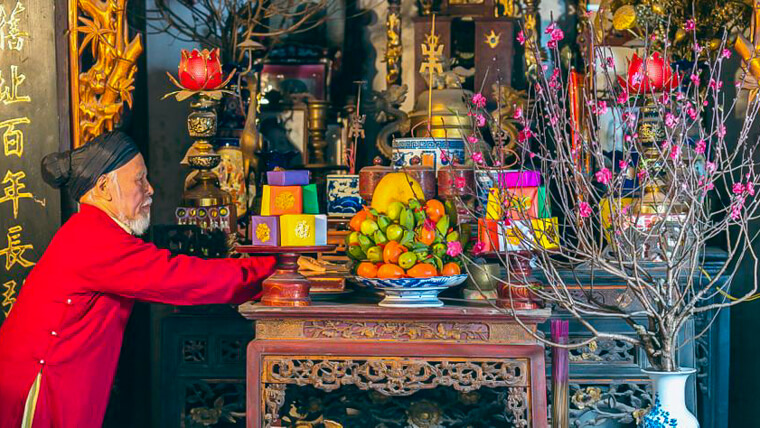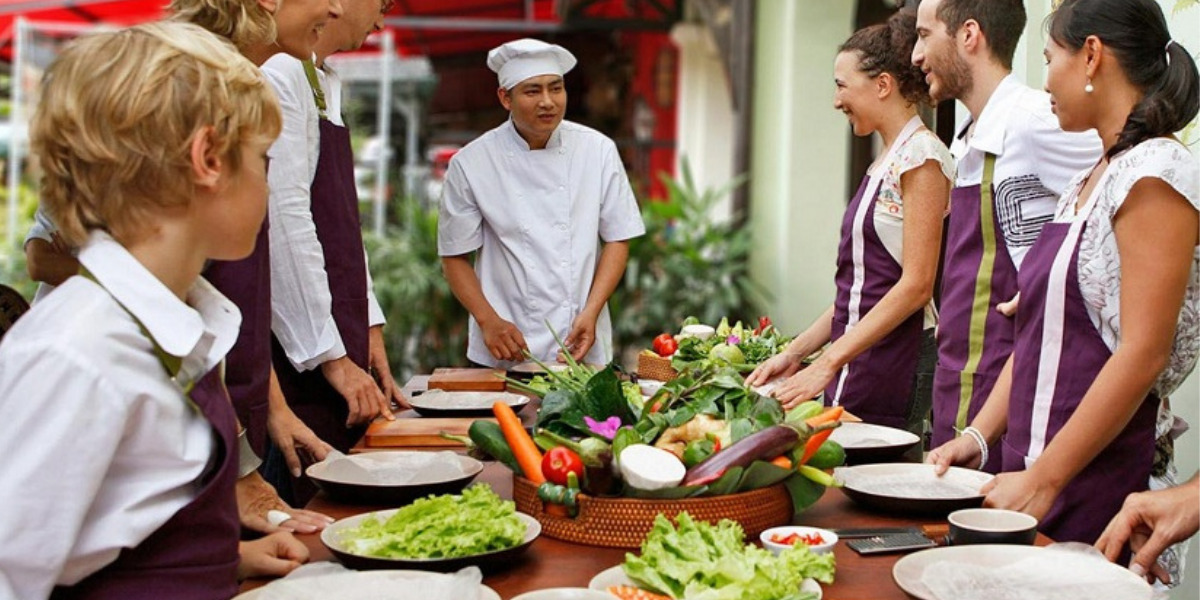In the traditional & local culture, Vietnamese altars play an integral part in the people's daily life, placed in the most sacred place of the house, set with ancestral tablets and an incense burner bowl in the center, inside which are incense sticks representing the universe. On both sides of the altar are commonly two candles, embodying the moon (right) and the sun (left). Worshiping ancestors and Gods has become a beautiful practice, the moral standard of the Vietnamese, which is of great significance in the spiritual life of Vietnamese people.
Vietnamese altars for spiritual purposes
Vietnamese ancestor altar

Ancestor worshiping ritual - Source: phatgiao
Worshiping ancestors is a fine ancient Vietnamese tradition aiming at paying tribute to deceased members in the family and reminding the offspring/ children of the merits of the preceding generations, which represents the filial piety of gratitude of the descendants to the parents and grandparents.
The direction of the altar is also crucial in the notions of the Vietnamese. Normally, the Vietnamese family altars face the South, considering the direction of creativity, wisdom, and vitality. Sometimes, the Vietnamese altars are placed in the position facing the West, symbolizing the harmony of Yin-Yang, peace, and thrivingness. The altar is elaborately decorated for special occasions such as the 1st and 15th day of the lunar months, the death anniversary, and especially the Tet holiday.
The altars in Vietnam dedicated to Kitchen God & God of Wealth
Kitchen God and the God of Wealth originated from Vietnamese spiritual culture and in some Eastern countries. The former is in charge of managing certain areas and the growth of crops, bringing about prosperity for the houses’ owners. The latter is believed to “protect” property and give good luck to the family.

Vietnamese altars dedicated to Kitchen God & God of Wealth - Source: 2sao.vietnamnetjsc
Although the God of Wealth is regarded as another image of the Kitchen God, both of them help people to gain more success in business. Hence, people usually worship these two Gods together. Unlike other types of altars, the altars of Kitchen God and God of Wealth are placed on the ground in a corner of the houses, shops, or event stores.
The principle for placing the altars is that the direction must be suitable to the houses’ owners' ages and feng-shui elements. The statue of the Kitchen God is located on the right and the other is on the left. On the Vietnamese altars, between two statues are a pot of rice, a jar of salt, and full water, which are only replaced at the end of the year. In the middle of the altar is a bowl of incense.
Vietnamese altar for the dead

Altar for the dead - Source: banthogodep
Setting up an altar for the recently passed people is an indispensable part of the Vietnamese funeral traditions, which requires care and meticulousness with the purpose of helping the deceased early salvage and bond with the ancestors.
The basic “elements” on the altar must include an incense bowl, flower vase, oil lamp, and five small cups of water. The living people must take care and never let the incense and oil lamps on the Vietnamese altars be put out within 49 days and nights. Before enjoying meals, the living people have to offer incense to the recently deceased to “invite” them back home and have meals with family.
The altar worshiping Vietnamese craft ancestors
The tradition of worshiping Vietnamese craft ancestors aims at paying tribute to not only craft ancestors who have merits in the establishment or invention of a particular craft village but also people who preserved and passed down the craft to the next generations. In addition, this tradition is an occasion to pray for success and good luck in business.
In craft villages, setting up Vietnamese altars and worshiping craft ancestors are traditions of Uong nuoc nho nguon (when drinking water, think of its source). These villages set up an altar by the local people, normally in the shrine. In Vietnam, there are several main death anniversaries of the profession in Vietnam solemnly organized by locals such as in the theater industry, the embroidery, trade, tailor, carpentry, construction, and hair.
Vietnamese altars for religious purposes

Alter to worship the Buddhist - Source: noithatmanhhe
In Vietnam, the most popular religions are Buddhism and Christianity. The Catholic altar in Vietnam is similar to that in Western countries. It is perhaps the most important part of any Catholic house, bringing happiness to family members and leading them to God. Depending on each family, the altar of God can be placed in the living room, terrace, or worshiping room.
On the altar in Vietnam there must be a Giesu statue, sometimes other statues in similar sizes such as Mary Mary, Saint Joseph, and Patron Saints. Furthermore, Vietnamese altars to Giesu set vases, aromatic oil bottles, photos, and a few fresh flowers. Burning incense, and lighting lamps and candles on the altar is an act to educate the descendants to remember God for being the creator of all creatures including human beings as well as express gratitude to their ancestors.
The Buddhist altar is placed in the center of the living room or the most sacred position in the house or even a private worshiping room. In the middle of the Vietnam altar is placed the statue of Buddha or the image of the Buddha Shakyamuni who protects the world today. People can worship the Three Realm Buddhas including the Realm of Desire, the Realm of Form, and the Realm of No-Form in the same size and position. On the Vietnamese altar table, there is an incense bowl, oil lamps, flower vase, fruit tray, bamboo tocsin, and water offering to the Buddha. The incense bowl is located in the front center, then 3 small cups of water. A pair of lamps are placed on the same level as the incense bowl if any.
Above is the overall information about Vietnamese altars from Localtravelidea. For more interesting information about Vietnamese culture and Vietnamese tourism, please access the Localtravelidea.com!







.jpg) — Ha Bich
— Ha Bich





































